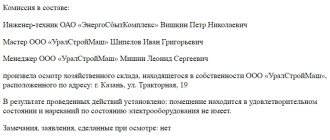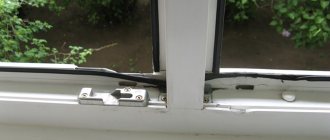Concept of crime scene inspection
The scene of the incident is a section of terrain or premises within which traces of a crime were found.
This implies that it could have been committed both in the place where its traces were found and in another. Inspection of the scene of an incident is an urgent investigative action aimed at establishing, recording and studying the situation at the scene of the incident, traces of the crime and the criminal, and other factual data that, together with other evidence, make it possible to draw a conclusion about the mechanism of the incident and other circumstances of the event under investigation.
If a crime is committed in one place, and traces of it are found in another, then there is both a crime scene and a crime scene. When a crime is committed in the same place where traces of it were found, the location of the incident and the crime coincide.
When starting an inspection, the investigator, as a rule, does not yet know whether the event under investigation, traces of which were found in a given place, is a crime or not, and if it is a crime, then whether it was committed here. Since the very discovery of traces of an event requiring investigation is always an incident, the place where these traces were found is the scene of the incident, and its inspection is an inspection of the scene of the incident.
From the above it follows that there is an inextricable connection between the scene of the incident and the crime under investigation:
- the crime was committed with the help of instruments remaining at this place or seized from this place;
- the crime is directed at one of the objects located at this location;
- traces of the criminal’s actions remained on the objects or objects that were in the criminal’s possession remained at the site;
- the crime was committed in a given environment, although it has not undergone significant changes due to this; The situation and its conditions could determine the criminal’s method of action and influence his achievement of his criminal goal.
The general task of examining the scene of an incident is to identify all types of relationships between the scene of the incident and the crime under investigation in order to use them, together with other data on the case, to establish the mechanism of the incident in all details, i.e., to answer the question of what happened at this place.
Particular tasks of inspecting the scene of the incident:
- studying and recording the situation at the scene of the incident;
- establishing the nature of the criminal’s impact on the environment;
- detection, recording and seizure of traces of the crime and the criminal;
- identifying the criminal and the motives for the crime;
- establishing the causes and conditions that contributed to the crime;
- obtaining the necessary data for subsequent investigative actions and operational search activities.
To solve each of these tasks, the investigator, if possible, must answer a number of questions. For example, by studying the situation of a crime scene, the investigator determines what paths lead to and from it, whether it is a crime scene, what is around and, in particular, where one could hear or see what was happening, whether the criminal could have entered the scene incidents unnoticed, how he moved, etc.
Inspection objects:
- the actual scene of the incident (location, boundaries, length, purpose of the premises or characteristics of the area);
- situation at the scene of the incident (characteristics of the objects located at this place, spatial connections between these objects - their position at the scene of the incident and their relative positions);
- dead body;
- traces of the crime and the criminal, other objects or documents located at the scene.
The corpse, objects, and documents found at the scene of the incident must be examined in conjunction with other objects. Immediate inspection of objects and documents at the place of discovery guarantees timely recording of their properties, characteristics and condition. Exceptions to this general rule are permitted only in cases where there are no adequate conditions for inspection.
Inspection of the scene of the incident and its situation is the study and recording of:
- relief and nature of the soil of the area, natural and artificial boundaries of the scene;
- the nature and location of the premises, adjacent buildings, paths leading to and from it, as well as obstacles on these paths;
- spatial arrangement of local objects, their position relative to each other and the distance between them;
- arrangement of objects in terms of their intended purpose and position during normal use;
- traces of the crime and the criminal;
- absence of objects and traces necessary in the given situation;
- the presence of objects, the very fact of their discovery in a given situation is unusual.
Of course, the range of objects to be examined and the degree of detail of their examination are determined by the specific situation.
Participants of the inspection
The inspection of the crime scene is organized by the investigator. He, along with the investigators, conducts such an inspection and is responsible for compliance with the legislative and methodological requirements for the inspection procedure.
In addition to representatives of the investigation, the inspection includes:
- Operatives.
- Experts in the field of forensics.
- Dog handlers.
- Other specialists whose knowledge is needed in a particular case.
All of them are part of the investigative team investigating the crime.
Attesting witnesses, interpreters, witnesses, the victim, the suspect and his lawyers can also participate in certain events.
An inquiry officer, investigator or prosecutor examines documents during the preliminary investigation.
In the case of an investigation into a murder or other death of a victim, a medical examiner or other physician must be present during the examination of the crime.
The issue of the participation of witnesses is related to the place where the crime was committed. It is possible to conduct an inspection without them if the place being inspected is located far away, there are no transport routes to it, or it is dangerous to be in the area.
If there are no witnesses, the inspection process and its details must be recorded using photos and videos, about which a special note must be made in the protocol.
Stages of crime scene inspection
The investigative examination of the crime scene can be divided into three stages:
- preparatory;
- worker;
- final.
Completeness, objectivity, methodicality and other general tactical provisions are realized only if the investigator’s work is clearly organized, if the inspection tasks are solved by him in a strictly defined sequence. The meaning of dividing the inspection of the crime scene into stages is, therefore, to systematize the actions of the investigator, ensuring the quality of the inspection.
Before beginning a direct study of the situation and objects at the scene of the incident, the investigator must create the necessary conditions for the inspection, determine its subject and the range of participants, and ensure work at the scene of the incident. All these actions of the investigator are an integral part of the inspection as a procedural act, and it is unthinkable without them. The system of such actions in its entirety forms the preparatory stage of the inspection .
The content of the working stage is direct examination of the objects of inspection. If the actions of the investigator at the preparatory stage are primarily organizational in nature, then here they acquire a research character.
Finally, at the final stage , the investigator actually sums up the work done and formalizes its results. The inspection as such is completed, but a number of methodological and organizational issues still need to be resolved, to ensure the possibility of using the inspection results during further investigation, which determines the content of the final stage.
Preparatory stage of crime scene inspection
It begins from the moment the investigator makes a decision to conduct an inspection. Having made such a decision, the investigator must:
- ensure security of the scene of the incident until your arrival, i.e. ensure the safety and integrity of the situation and traces of the crime;
- take measures to prevent or mitigate the harmful consequences of a crime (for example, order increased measures to eliminate a fire);
- ensure at the time of your arrival the presence near the scene of the incident of persons who can provide the necessary information: eyewitnesses of the crime, if they are known, and other witnesses, for example, who discovered traces of the crime;
- determine in advance which specialists should be involved in the inspection and ensure their arrival;
- make proposals on the composition of the operational group going to the inspection site;
- check the readiness of technical inspection equipment.
From the moment of his arrival at the scene of the incident, the second period of the preparatory phase begins. Direct inspection is preceded by:
- taking measures to provide necessary medical care to victims if it was not provided;
- removal of all unauthorized persons from the scene of the incident;
- attracting witnesses to participate in the inspection and final determination of the circle of other participants in the inspection, instructing inspection participants about their rights and responsibilities;
- collecting, through a survey (informal, non-recorded conversation, in which it is useful to involve invited specialists), preliminary information that should be taken into account during the inspection, establishing what changes, by whom and for what purpose were made at the scene of the incident;
- carrying out other urgent actions dictated by circumstances, and taking measures aimed at improving inspection conditions (providing artificial lighting, etc.).
Both at this and at subsequent stages, the necessary search activities are carried out, carried out in parallel with the inspection, for example, the pursuit of a criminal, the use of a search dog.
Working stage of crime scene inspection
It consists of
- general examination;
- detailed inspection.
A general inspection begins with a review of the scene of the incident in order to:
- orientation;
- determining the boundaries of the space to be inspected;
- resolving the issue of the starting point and method of inspection, i.e. determining its sequence;
- choosing a position for orientation and overview photography.
Then the investigator, together with other participants in the inspection, finds out what objects are at the scene of the incident, examines the entire range of issues related to its situation, determines the relative location and relationship of the elements of this situation, studies their appearance, condition and with the maximum necessary and possible in the given conditions records in detail everything discovered using photographs, drawing up diagrams, plans and drawings and the necessary notes for the future inspection report.
At the end of the general investigator moves on to a detailed examination , during which:
- objects are examined carefully and in detail (for these purposes they can be moved from their place, turned over, etc.);
- all available measures are taken to search and detect traces of the crime and the criminal at the scene of the incident and at individual objects;
- objects with traces on them are selected, traces are removed from those objects that cannot be seized, and if this is impossible, copies are made from them;
- negative signs of the condition of objects are recorded;
- general inspection data is checked;
- Nodal and detailed photographs are taken.
When reviewing the scene of an incident, the investigator chooses the method of inspection, i.e., determines its order, the principle that determines the sequence of studying the objects of inspection. In forensics, three main methods of examining a crime scene are used: concentric, eccentric and frontal (used both in pure and combined form):
- concentric method - the inspection is carried out from the periphery to the center of the crime scene, which usually means the most important object (a corpse, a broken safe, etc.) or a conventional point;
- the eccentric method (the “unfolding spiral” method) consists in the fact that the inspection is carried out from the center of the scene of the incident to its periphery;
- The frontal method is a linear inspection of areas from one of the boundaries, taken as the initial one, to the other.
In addition to the listed methods, in the legal literature they sometimes talk about inspection methods, usually calling subjective and objective methods.
When examining the scene of an incident using the subjective method, the investigator seems to follow the path of movement of the criminal, the subject of the crime. Changes in the environment in which the crime was committed that are not directly related to the actions of the criminal or related to the actions of other persons participating in the event remain outside his field of vision, although both of them may be of significant importance for establishing the truth in the case. In fact, this method means selective inspection of individual elements of the scene.
With the objective method, everything is examined as a whole, regardless of (albeit taking into account) the routes of movement of the criminal. This is a complete inspection of all elements of the crime scene. It is in relation to such an inspection that we can talk about the named methods as an expression of the sequence of inspection of objects at the scene of the incident.
In domestic criminology, preference is given to the objective method.
The initial examination is carried out by the investigator for the first time, i.e. the scene of the incident has not yet been examined by either the preliminary investigation authorities or the inquiry authorities (although the situation may have already undergone certain changes). Various types of inspections by the administration and representatives of departmental inspections do not change the nature of the initial inspection, since it is understood as an investigative inspection. The scene of the incident is examined in its entirety, in all details.
When re-inspecting, the object may not be all, but only individual elements of the scene of the incident.
Everything said above about methods also applies to repeated inspection. The only peculiarity is that in the case of repeated inspection of individual objects, we may not be talking about the method of inspection in the usual sense, but about compiling a list of objects to be inspected and their serial numbering.
An additional inspection should be distinguished from a repeated , in which the investigator deals with objects that have not previously been inspected, i.e., in relation to them, this inspection will be initial. At the same time, the need to review the entire scene of the incident arises in cases where, during the initial inspection, most of the objects that determine the overall picture of the scene of the incident were not examined by the investigator.
During an additional inspection, depending on the number and condition of objects, all of the above methods can be used, as well as compiling a list, as with a repeated inspection.
The final stage of the crime scene inspection
Having completed the examination of objects at the scene of the incident, the investigator proceeds to the final stage of the inspection:
- draws up an inspection report and the necessary plans, diagrams and drawings; .
- if necessary, fingerprints the corpse and sends it to the morgue (when autopsying a corpse at the place of discovery, the investigator, at the end of the final stage of the examination, takes part in a forensic medical examination of the corpse);
- packages objects seized from the scene of the incident (it is important to know that delivery of research objects for examination is the responsibility of the authorities at whose request it is carried out);
- takes measures to preserve those objects of evidentiary value that are impossible or impractical to seize;
- takes action on statements received from inspection participants and other persons related to the inspection of the scene of the incident.
The investigator must evaluate all the work done from the point of view of its completeness and success. And at the same time, he must remember that the inspection data, supported by other evidence, are insufficient to resolve the case on the merits.







